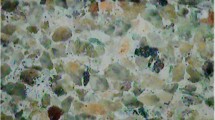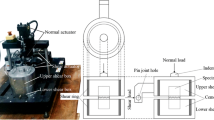Abstract
Hydro-chemical erosion has a great effect on the micro-structure morphology and macroscopic mechanical properties of the rock mass. In this paper, direct shear test system was used to study the hydro-chemical effect on the shear strength characteristics of limestone fractures. Besides, morphology parameters of the fracture under different chemical solutions were also analyzed through three-dimensional laser scanning and electron microscope imaging. Experimental results showed that after hydro-chemical erosion, the profile mean square root deviation Sq, the profile area ratio Rs, the profile peak point density Spd increased, while the slope mean square root Sdq decreased. Combined with scanning electron microscope (SEM) images, it is found that due to the hydro-chemical erosion, the roughness of limestone fracture surface, the discreteness of height distribution of the asperities and the JRC2D values increased, but the slope of asperities decreased. There was a good exponential relation between the decrease percentage of limestone internal friction angle and soaking time, and a logarithmic relation between the decrease percentage of cohesion and soaking time. According to the gray correlation method, the influencing factors were ranked in descending order as follows: normal stress, soaking time and pH values. In addition, the JRC2D value had a negative linear correlation with internal friction angle and cohesion of limestone fracture.













Similar content being viewed by others
Abbreviations
- S h :
-
The maximum peak height
- S v :
-
The maximum valley depth t Sq
- S q :
-
The profile mean square root deviation
- R s :
-
The profile area ratio
- S pd :
-
The profile peak point density
- S dq :
-
The slope mean square root
- JRC 2D :
-
The two-dimensional roughness coefficient of rock fracture surface
- Z 2 :
-
The two-dimensional slope root mean square
- φ 1, φ 2 :
-
The internal friction angle of limestone fracture before and after hydro-chemical erosion
- D :
-
The decrease percentage of the internal friction angle
- C 1, C 2 :
-
The cohesion of dry limestone fracture
- F :
-
The decrease percentage of cohesion
- p 1 to p 6 :
-
The fit parameters
- t :
-
The soaking time
- z(k):
-
The reference sequence
- x i(k):
-
The comparison sequence
- ρ :
-
The resolution coefficient
- r i :
-
The gray correlation degree
- ζ 1, ζ 2, ζ 3 :
-
Stand for the pH values, soaking time and normal stress in the gray correlation method
References
Abdoulghafour H, Luquot L, Gouze P (2013) Characterization of the mechanisms controlling the permeability changes of fractured cements flowed through by CO2-Rich Brine. Environ Sci Technol 47(18):10332–10338. https://doi.org/10.1021/es401317c
Cai YY, Yu J, Fu GF, Li H (2016) Experimental investigation on the relevance of mechanical properties and porosity of sandstone after hydrochemical erosion. J Mt Sci 13(11):2053–2068. https://doi.org/10.1007/s11629-016-4007-2
Chai ZY, Kang TH, Feng GR (2014) Effect of aqueous solution chemistry on the swelling of clayey rock. Appl Clay Sci 93–94:12–16. https://doi.org/10.1016/j.clay.2014.02.027
Chen CC, Peng SJ, Wu SK, Xu J (2019) The effect of chemical erosion on mechanical properties and fracture of sandstone under shear loading: an experimental study. Sci Rep 9(1):19886. https://doi.org/10.1038/s41598-019-56196-2
Chen Y, Cao P, Chen R, Teng Y (2010) Effect of water-rock interaction on the morphology of a rock surface. Int J Rock Mech Min Sci 47(5):816–822. https://doi.org/10.1016/j.ijrmms.2010.03.009
Chen Y, Cao P, Mao DW, Pu CZ, Fan X (2014) Morphological analysis of sheared rock with water–rock interaction effect. Int J Rock Mech Min Sci 70:264–272. https://doi.org/10.1016/j.ijrmms.2014.05.002
Day JJ, Diederichs MS, Hutchinson DJ (2017) New direct shear testing protocols and analyses for fractures and healed intrablock rockmass discontinuities. Eng Geol 229:53–72. https://doi.org/10.1016/j.enggeo.2017.08.027
Deng H, Fitts JP, Crandall D, McIntyre D, Peters CA (2015) Alterations of fractures in carbonate rocks by CO2-acidified brines. Environ Sci Technol 49(16):10226–10234. https://doi.org/10.1021/acs.est.5b01980
Ding WX, Feng XT, Chen BR (2007) Study on the mechanical property and the evolutionary neural network constitutive model for limestone under chemical corrosive environments. Key Eng Mater 340–341:1169–1174. https://doi.org/10.4028/www.scientific.net/KEM.340-341.1169.
Ellis B, Peters C, Fitts J, Bromhal G, McIntyre D, Warzinski R, Rosenbaum E (2011) Deterioration of a fractured carbonate caprock exposed to CO2-acidified brine flow. Greenh Gases Sci Technol 1(3):248–260. https://doi.org/10.1002/ghg.25
Fan GW, Chen MW, Zhang DS, Wang Z, Zhang SZ, Zhang CG, Li QZ, Cao BB (2018) Experimental study on the permeability of weakly cemented rock under different stress states in triaxial compression tests. Geofluids 2018:1–9. https://doi.org/10.1155/2018/9035654
Feng XT, Ding WX (2007) Experimental study of limestone micro-fracturing under a coupled stress, fluid flow and changing chemical environment. Int J Rock Mech Min Sci 44(3):437–448. https://doi.org/10.1016/j.ijrmms.2006.07.012
Feng XT, Chen SL, Zhou H (2004) Real-time computerized tomography (CT) experiments on sandstone damage evolution during triaxial compression with chemical corrosion. Int J Rock Mech Min Sci 41(2):181–192. https://doi.org/10.1016/S1365-1609(03)00059-5
Feng XT, Ding WX, Zhang DX (2009) Multi-crack interaction in limestone subject to stress and flow of chemical solutions. Int J Rock Mech Min Sci 46(1):159–171. https://doi.org/10.1016/j.ijrmms.2008.08.001
Geist R (1998) Four-stage model for predicting creep behavior. J Eng Mech 124(1):118–120. https://doi.org/10.1061/(ASCE)0733-9399(1998)124:1(118)
Gu DM, Huang D, Liu HL, Zhang WG, Gao XC (2019) A DEM-based approach for modeling the evolution process of seepage-induced erosion in clayey sand. Acta Geotech 14(6):1629–1641. https://doi.org/10.1007/s11440-019-00848-0
Gu DM, Huang D, Zhang WG, Gao XC, Yang C (2020) A 2D DEM-based approach for modeling water-induced degradation of carbonate rock. Int J Rock Mech Min Sci 126(2):104188. https://doi.org/10.1016/j.ijrmms.2019.104188
Guo JQ, Xu ZL, Li HF (2015) Influence of water-saturated state on mechanical properties and longitudinal wave velocity of karst limestone. J civ Archit Environ Eng 37(02):60–66. https://doi.org/10.11835/j.issn.1674-4764.2015.02.010
Han T, Wang X, Li D (2019) Damage and degradation mechanism for single intermittent cracked mortar specimens under a combination of chemical solutions and dry-wet cycles. Constr Build Mater 213:567–581. https://doi.org/10.1016/j.conbuildmat.2019.04.085
Han TL, Shi JP, Chen YS, Cao XS (2018) Quantifying microstructural damage of sandstone after hydrochemical corrosion. Int J Geomech 18(10):04018121.1-04018121.13. https://doi.org/10.1061/(ASCE)GM.1943-5622.0001237
Han TL, Shi JP, Chen YS, Cao XS (2019) Mechanism damage to mode-i fractured sandstone from chemical solutions and its correlation with strength characteristics. Pure Appl Geophys 176(1):1–23. https://doi.org/10.1007/s00024-019-02237-w
Huang BL, Yin YP, Liu GN, Wang SC, Chen XT, Huo ZT (2012) Analysis of waves generated by Gongjiafang landslide in Wu Gorge, three Gorges reservoir, on November 23, 2008. Landslides 9(3):395–405. https://doi.org/10.1007/s10346-012-0331-y
Huang BL, Yin YP, Zhang ZH, Wang J, Qin Z, Yan GQ (2019) Study on deterioration characteristics of shallow rock mass in water the level fluctuation zone of karst bank slopes in Three Gorges Reservoir area. Chinese Journal of Rock Mechanics and Engineering 38(9):1786–1796. https://doi.org/10.13722/j.cnki.jrme.2018.1535
Hutchinson AJ (1993) Stone Degradation Due to Wet Deposition of Pollutants. Corros Sci 34(11):1881–1898. https://doi.org/10.1016/0010-938X(93)90025-C
Indraratna B, Thirukumaran S, Brown ET, Zhu SP (2015) Modelling the Shear Behaviour of Rock Joints with Asperity Damage Under Constant Normal Stiffness. Rock Mech Rock Eng 48(1):179–195. https://doi.org/10.1007/s00603-014-0556-2
Li B, Ye XN, Dou ZH, Zhao ZH, Li YC, Yang Q (2020) Shear Strength of Rock Fractures Under Dry, Surface Wet and Saturated Conditions. Rock Mech Rock Eng 53:2605–2622. https://doi.org/10.1007/s00603-020-02061-y
Li FB, Sheng JC, Zhan ML, Xu LM, Wu Q, Jia CL (2014) Evolution of limestone fracture permeability under coupled thermal, hydrological, mechanical, and chemical conditions. Journal of Hydrodynamics, Ser. B 26(2): 234–241. https://doi.org/10.1016/S1001-6058(14)60026-3
Li H, Zhong ZL, Eshiet II, Shen Y, Liu XR, Yang DM (2020) Experimental Investigation of the Permeability and Mechanical Behaviours of Chemically Corroded Limestone Under Different Unloading Conditions. Rock Mech Rock Eng 53:1587–1603. https://doi.org/10.1007/s00603-019-01961-y
Lin Y, Zhou KP, Li JL, Ke B, Gao RG (2020) Weakening Laws of Mechanical Properties of Sandstone Under the Effect of Chemical Corrosion. Rock Mech Rock Eng 53:1857–1877. https://doi.org/10.1007/s00603-019-01998-z
Liu Y, Huang D, Cen DF, Zhong Z, Gong FX, Wu ZJ, Yang YT (2021) Tensile strength and fracture surface morphology of granite under confined direct tension test. Rock Mech Rock Eng 54(9):4755–4769. https://doi.org/10.1007/s00603-021-02543-7
Lu ZD, Chen CX, Feng XT, Zhang YL (2014) Strength failure and crack coalescence behavior of sandstone containing single pre-cut fissure under coupled stress, fluid flow and changing chemical environment. Journal of Central South University 21(3):1176–1183. https://doi.org/10.1007/s11771-014-2051-z
Noiriel C, Made B, Gouze P (2007) Impact of coating development on the hydraulic and transport properties in argillaceous limestone fracture. Water Resour Res 43(9):2363–2367. https://doi.org/10.1029/2006WR005379
Noiriel C, Gouze P, Made B (2013) 3D analysis of geometry and flow changes in a limestone fracture during dissolution. J Hydrol 486(8):211–223. https://doi.org/10.1016/j.jhydrol.2013.01.035
Pellet FL, Keshavarz M, Boulon M (2013) Influence of humidity conditions on shear strength of clay rock discontinuities. Eng Geol 157:33–38. https://doi.org/10.1016/j.enggeo.2013.02.002
Qiao LP, Wang ZC, Huang AD (2017) Alteration of Mesoscopic Properties and Mechanical Behavior of Sandstone Due to Hydro-Physical and Hydro-Chemical Effects. Rock Mech Rock Eng 50(2):255–267. https://doi.org/10.1007/s00603-016-1111-0
Fuchs SJ, Nicholas Espinoza D, Lopano CL, Akono A-T, Werth CJ (2019) Geochemical and geomechanical alteration of siliciclastic reservoir rock by supercritical CO2-saturated brine formed during geological carbon sequestration. Int J Greenhouse Gas Control 88:251–260. https://doi.org/10.1016/j.ijggc.2019.06.014
Sato A, Obara Y (2017) Analysis of Pore Structure and Water Permeation Property of a Shale Rock by Means of X-Ray CT. Procedia Engineering 191:666–673. https://doi.org/10.1016/j.proeng.2017.05.230
Shakoor A, Barefield EH (2009) Relationship between unconfined compressive strength and degree of saturation for selected sandstones. Environ Eng Geosci 15(1):29–40. https://doi.org/10.2113/gseegeosci.15.1.29
Vergara MR, Triantafyllidis T (2016) Influence of water content on the mechanical properties of an argillaceous swelling rock. Rock Mech Rock Eng 49(7):2555–2568. https://doi.org/10.1007/s00603-016-0938-8
Wang FG, Zhao YJ, Li C, Li CS, Lan TS, Ping SF, Cao YQ (2019) An experimental study on the corrosion characteristics of the karst tunnel engineering area in Southwest China. Bull Eng Geol Env 78(6):4047–4061. https://doi.org/10.1007/s10064-018-1411-6
Xie SY, Shao JF, Xu WY (2011) Influences of chemical degradation on mechanical behaviour of a limestone. Int J Rock Mech Min Sci 48(5):741–747. https://doi.org/10.1016/j.ijrmms.2011.04.015
Zhao ZH, Yang J, Zhou D, Chen YF (2017) Experimental investigation on the wetting-induced weakening of sandstone joints. Eng Geol 225:61–67. https://doi.org/10.1016/j.enggeo.2017.04.008
Zou LC, Li B, Mo YY, Cvetkovic V (2020) A high-resolution contact analysis of rough-walled crystalline rock fractures subject to normal stress. Rock Mech Rock Eng 53(5):2141–2155. https://doi.org/10.1007/s00603-019-02034-w
Acknowledgements
This work was supported by National Natural Science Foundation of China (Nos. 51774268, 51109076), Key Research and Development project of Shanxi Province (No. 20201101009). Besides, the authors are also grateful to the anonymous reviewers for their many helpful comments, which have greatly improved this paper.
Author information
Authors and Affiliations
Corresponding author
Additional information
Publisher's Note
Springer Nature remains neutral with regard to jurisdictional claims in published maps and institutional affiliations.
Rights and permissions
About this article
Cite this article
Luo, T., Fan, G., Guo, B. et al. Experimental study on the influence of hydro-chemical erosion on morphology parameters and shear properties of limestone fractures. Acta Geotech. 16, 3867–3880 (2021). https://doi.org/10.1007/s11440-021-01365-9
Received:
Accepted:
Published:
Issue Date:
DOI: https://doi.org/10.1007/s11440-021-01365-9




